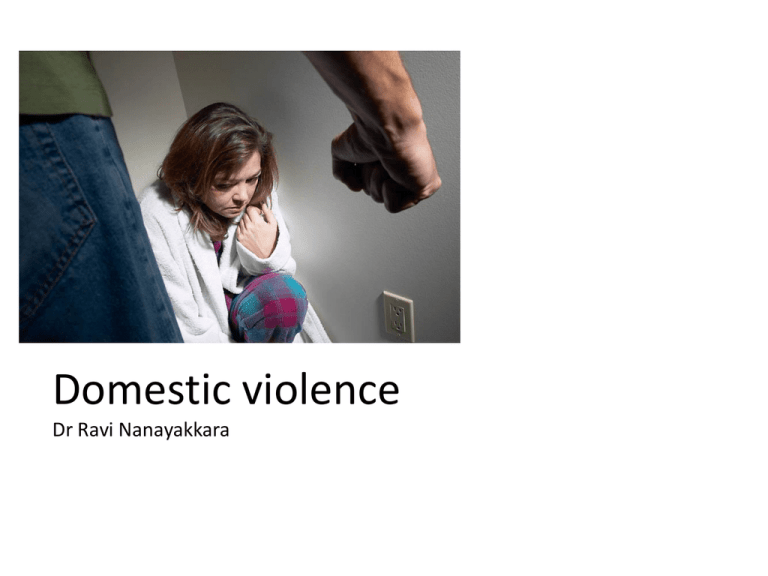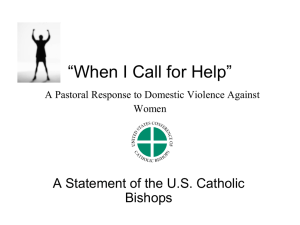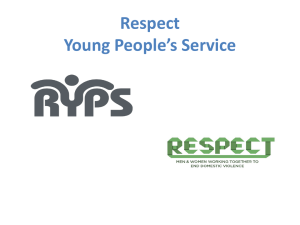
Domestic violence
Dr Ravi Nanayakkara
Objectives
• Discuss what is meant by domestic violence,
diagnosis of domestic violence and medico
legal issues
Violence
The World Health Organization (WHO) declares violence as
intentional use of physical force or power, threatened
or action against one self, another or against a group
or community that either results in or has a
high likelihood of injury, death, psychological
harm, maldevelopment.
• This definition excluded unintentional incidents such as
road traffic injuries.
Violence
• Self directed
• Interpersonal
• Collective
Violence
Self-directed
Suicidal
behavior
Self abuse
Interpersonal
Family/
partner
Child
Nature of violence
Physical
Sexual
Psychological
Deprivation or neglects
Community
Elder
PARTNER
Collective
social
Acquaintance
Stranger
Economic
Political
Model to illustrate the multiple levels of violence
4
3
2
1. Biological and personal factors
2. Relationship with peers, intimate partners etc.
3. Factors related to the community
4. Societal factors that influence violence
1
Domestic violence
• Violence occurred at home/domestic
environment
• Intimate partner violence
Wife battery
• Child abuse
• Abuse of elderly
• Domestic violence is a pattern of coercive
behavior used to establish power and control
over another person--usually an intimate
partner. It happens when one person believes
they are entitled to control another and can
include physical, psychological, emotional,
verbal, sexual, and/or economic abuse
• Why does domestic violence happen?
Abusive relationships can develop gradually.
There is a definite cycle that combines
the good times with often subtle abusive acts
that allow the abuser to gain power and
control over the relationship and, eventually,
lead the victim to emotional dependence
and learned helplessness. By the time a
pattern has emerged there are often children
involved, financial ties, and emotional bonds
that are difficult to break.
Intimate partner violence
• Intimate partner violence is defined as
violence instigated by marital, cohabiting or
any other partner within intimate
relationships.
Battered wife
• A woman who has suffered demonstrable and
repeated physical injuries at the hands of the
man with whom she lives or from the father of
one of her children.
ICD 995.81
• Intimate Partner Violence (IPV) is a currently
emerging problem in Sri Lanka. Although
during the past it was thought of as a private
matter in the family, now there is some
awareness among the community.
• Intimate Partner Violence/Domestic violence
Violence against women at home
1988 Jaffna
1998 Colombo
• Associated with
• Poverty
• Poor education
• Alcohol
• Injuries
Head and face
Blunt injuries prominent
Contusions mainly
• Sources of Accident Service of National
Hospital Sri Lanka stated 5-10% of annual
admissions to the unit were following
domestic violence.
Risk factors for IPV
• Socio economic factors
• Factors related to health of both partners
• Factors related to the partnership of both
individuals
• Factors related to the male partner
• Previous violence
• Socio economic factors
– Poverty
– Low socio economic status of the male partner
– Low socio economic status of both partners
– Low female contribution to household income
– Poor education of the women
– Poor education of the man
– Young age of the women
– Single marital status
– Urban residence
– Parity
• Factors related to health of both partners
Fair / poor mental health of the women
Partners’ poor mental health
Women’s self reported poor health
• Factors related to the partnership of both individuals
• History of the violence in husband’s family
• Parity
• Female sterility /not having children
• Relationship being longer
• Prior domestic violence
• Sexual jealousy
• Having other partner/s
• Conflicts about man’s infidelity
• Conflicts about sex
• Factors related to the male partner
Cigarette smoking
Alcohol consumption by male
Drug abuse by the partner
Man’s boy child preference /not having a male child
Involvement in fights at work or in the community
Previous violence
• Violence in woman’s childhood
• Woman abused by the parents
• History of violence in husbands family
Triggers for IPV
•
•
•
•
•
•
•
•
Not obeying the man
Arguing back
Not having food ready on time
Not caring adequately for the children or home
Questioning the man about money or girl friends
Going somewhere without the man’s permission
Refusing the man sex
Man suspecting the woman of infidelity
Types of abuse
Acts of physical aggression (Slapping, Hitting,
beating)
Psychological abuse (Threats, intimidation, etc).
Forced intercourse and other forms of sexual
abuse
Various controlling behaviors (Isolation,
Restriction of access to assistance)
Presentation to JMO
• Referred by OPD/ward
• Directly from police during their complaint
• Various organizations
• WIN, Kantha Pihita…
Identification IPV
• History
– Some time victim wants to hide
– Ask directly
– False story
– Risk factors
Injury pattern
• Anatomical area
o Head and face
o Upper limbs
o Lower limbs
o Neck
o Chest and abdomen
300
250
200
150
100
50
0
Head
and face
Neck
Chest
antr.
Chest
P o str.
A bdo m
en antr.
A bdo m
en
P o str.
pelvis
Upper
limb
right
Upper
limb left
Lo wer
Limb
right
Lo wer
Limb left
Study gruo p
266
31
40
37
26
16
3
80
82
32
39
Co mparative gro up
131
13
74
19
23
28
1
121
87
44
16
Study gruop
Comparative group
Injury pattern
• Nature of injuries
o Contusions
o Abrasions
o Lacerations
o Cuts
o Burns
o Fractures
o Stabs
Injury pattern
•
•
•
•
Severity / category
80% simple/non grievous
20% Grievous
<1% FIOCN/NF
The distribution of the category of hurt among the
FSIPV
Offending weapon
• House hold blunt weapon
• Broom
• Clubs
• Cutting weapons
• Acid
• Hot water
FSIPV
Mode of
assault
FSGV
No.
%
(n=300)
No.
%
(n=300)
Hand
Hands and
feet
Blunt
household
weapons
Sharp
household
weapons
Weapons used
for crimes
Chemicals
193
64.3
128
42.7
65
21.7
48
16.0
91
30.3
73
24.3
43
14.3
59
19.6
3
1.0
43
14.3
5
1.6
6
2.0
Hot water
Attempted to
kill
Others
4
1.3
5
1.7
9
3.0
14
4.7
13
4.3
16
5.3
Health consequences of IPV
• Physical
• Psychological
• Sexual
• Physical
Abdominal/ thoracic injuries
Bruises and cuts
Chronic pain syndrome
Disability
Fibromyalgia
Fracture
Gastrointestinal disorder
Irritable bowel syndrome
Laceration and abrasion
Ocular damage
Reduced physical functioning
• Sexual and reproductive
Gynaecological disorder
Infertility
Pelvic inflammatory disease
Pregnancy complication
Sexual dysfunction
Sexually transmitted diseases including HIV
Unsafe abortion
Unwanted pregnancy
• Physiological and behavioral
Alcohol and drug abuse
Depression and anxiety
Eating and sleeping disorder
Feeling of shame and guilt
Phobias and panic disorder
Physical inactivity
Poor self-esteem
Post-traumatic stress disorder
Psychosomatic disorder
Smoking
Suicidal behavior and self-harm
Unsafe sexual behavior
Postmortem findings
• Not common
• History – Risk factors, triggers
• External injuries
• Blunt injuries
• Sharp injuries
• Acid burns
• Internal injuries
• Musculo skeletal dissection
Medical officers duty
•
•
•
•
•
•
•
Acute management
Management of consequences of IPV
Refer to police
Refer for counseling, including partner
Guide for social support – WIN…
Guide for legal support – LAC
Follow up including local health care provider
Prevention of IPV
•
•
•
•
•
•
•
•
•
•
Social support for the victims (Occupation, shelter)
Legal assistance for the victims
Create organizations/groups for support
Change social attitude
Special police women desks / WPC
Educational programmes (School – public)
Address the risk factors
Create/amend the laws to punish offenders
Manage/Follow up the offenders
Counseling service (Both)
Laws related to Domestic violence
Abuse of Elderly
• Definition
Elder abuse is a single or repeated act or lack
of appropriate action occurring within any
relationship where there is an expectation of
trust which causes harm or distress to an elder
person.
Act of commission or omission.
Types of abuse
• Physical abuse – the infliction of pain or injury.
• Psychological or emotional abuse – the
infliction of mental anguish.
• Financial or material abuse – the illegal or
improper exploitation or use of funds or
resources of old person.
Contd..
• Sexual abuse – non-consensual sexual contact
of any kind with older person.
• Neglect – refusal or failure to fulfill a care
giving obligation. This may or may not involve
a conscious and intentional attempt to inflict
physical or emotional distress on the older
person.
Risk factors..
• Individual factors.
• Relationship factors.
• Community and society factors.
Health consequences
•
•
•
•
Depression
Psychological distress
Suicide tendency
Physical illness due to negligence…..
Medical officers duty..
Prevention..
Thank you!










